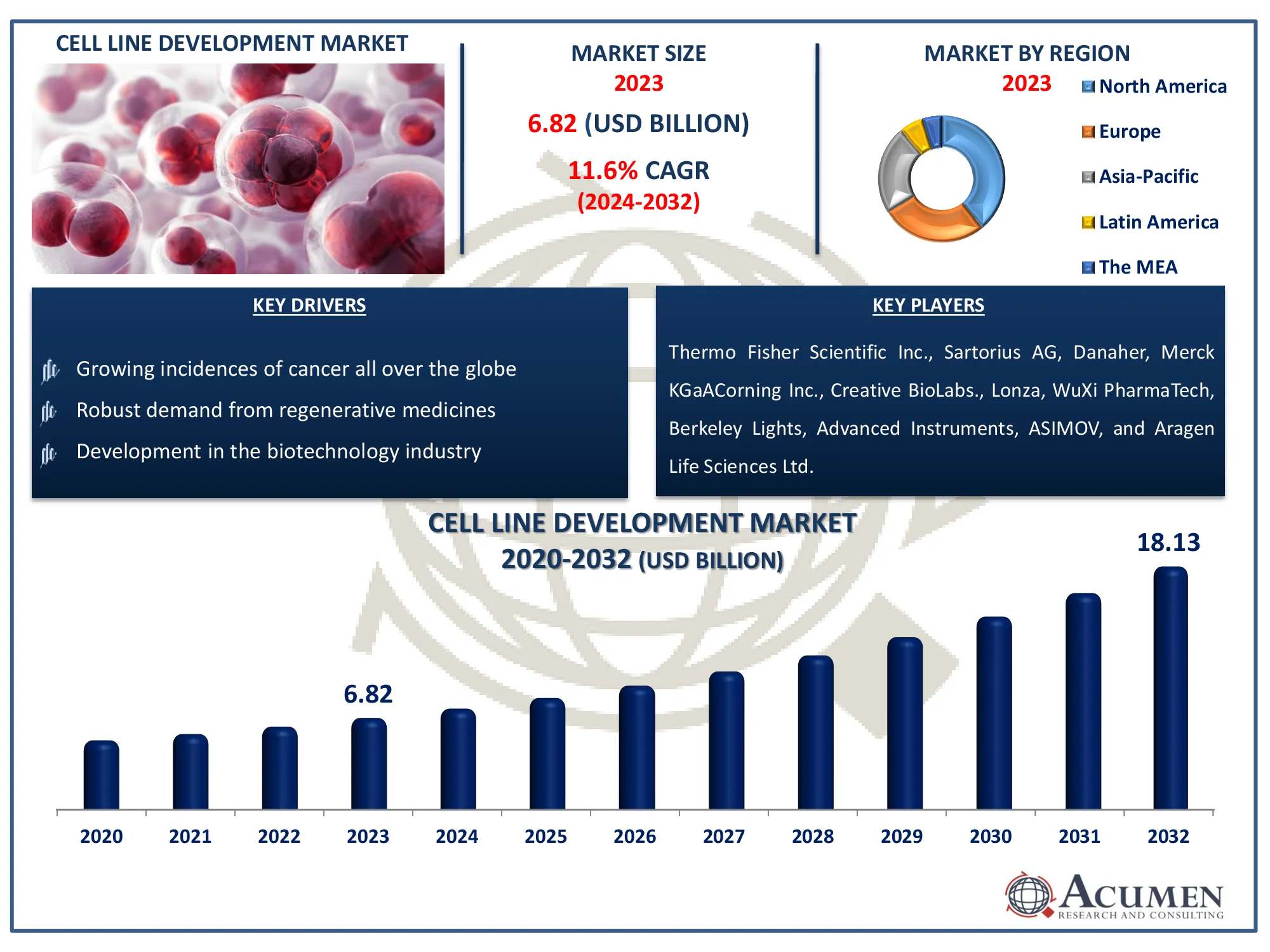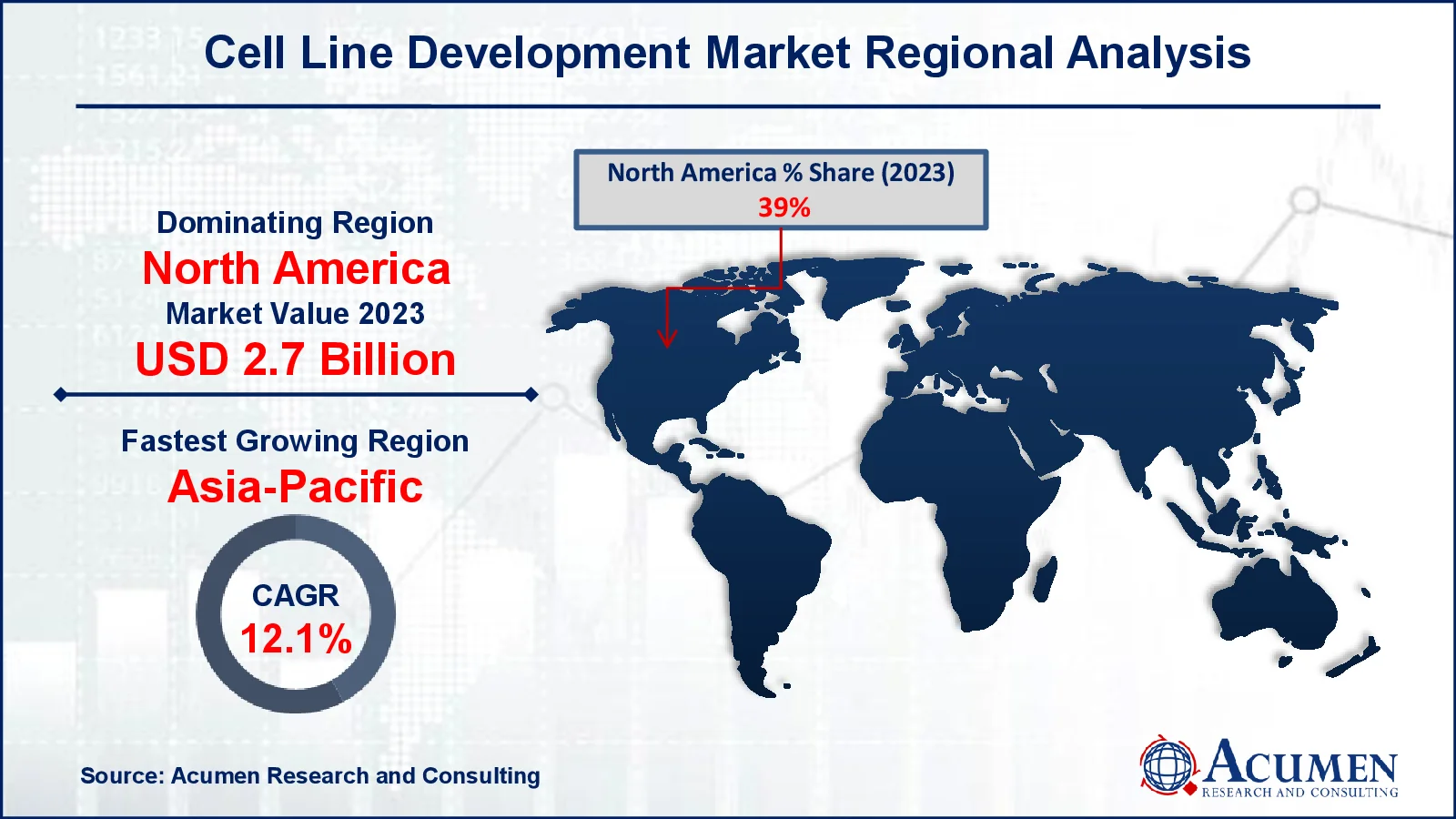March 2025
The Global Cell Line Development Market Size accounted for USD 6.82 Billion in 2023 and is estimated to achieve a market size of USD 18.13 Billion by 2032 growing at a CAGR of 11.6% from 2024 to 2032.
The Global Cell Line Development Market Size accounted for USD 6.82 Billion in 2023 and is estimated to achieve a market size of USD 18.13 Billion by 2032 growing at a CAGR of 11.6% from 2024 to 2032.

Cell line development is a process of co-opting cellular machinery to produce therapeutic biological agents and other implicated proteins. Moreover, the development of stable and high-production cell lines is extremely crucial for the production of biotherapeutic products such as bispecific monoclonal antibodies, monoclonal antibodies, fusion proteins, and vaccines. For the development of cell lines, different expression systems can be used: bacterial, yeast, plant, and mammalian. The cost of drug discovery and development is extremely high. However, to reduce development costs, researchers are under increasing pressure to quickly and efficiently complete the early stages of biotherapeutic exploration and selection of biotherapeutic candidates. Additionally, these cell lines can also be used to conduct drug development research, screening, and large-scale production of compounds.
|
Market |
Cell Line Development Market |
|
Cell Line Development Market Size 2023 |
USD 6.82 Billion |
|
Cell Line Development Market Forecast 2032 |
USD 18.13 Billion |
|
Cell Line Development Market CAGR During 2024 - 2032 |
11.6% |
|
Cell Line Development Market Analysis Period |
2020 - 2032 |
|
Cell Line Development Market Base Year |
2023 |
|
Cell Line Development Market Forecast Data |
2024 - 2032 |
|
Segments Covered |
By Products & Service, By Source, By Type of Cell Line, By Application, and By Geography |
|
Regional Scope |
North America, Europe, Asia Pacific, Latin America, and Middle East & Africa |
|
Key Companies Profiled |
Thermo Fisher Scientific Inc., Sartorius AG, Danaher, Merck KGaA, Corning Inc., Creative BioLabs., Lonza, WuXi PharmaTech, Berkeley Lights, Advanced Instruments, ASIMOV, and Aragen Life Sciences Ltd. |
|
Report Coverage |
Market Trends, Drivers, Restraints, Competitive Analysis, Player Profiling, Covid-19 Analysis, Regulation Analysis |
The rising frequency of cancer in developing and underdeveloped nations is a major driver of the cell line development market. The increase in the adoption of regenerative medicines, rising cancer prevalence globally, and soaring R&D investments by biotechnology and pharmaceutical companies are driving the cell line development market growth. Furthermore, the consistent investigation into drug discovery practices is expected to drive market growth over the forecast period.
Furthermore, the increased emphasis on monoclonal antibody production and gene therapy breakthroughs is offering major potential in the industry. The desire for biosimilars and personalized treatment is also driving the use of cell line development approaches. Collaborations between research institutes and biotech companies are increasing, spurring innovation and leading to better cell line creation procedures. However, the difficulty in developing stable cell lines, as well as increased contamination from rigorous purification techniques, may limit market expansion.
Furthermore, the high expenses of cell culture material and equipment pose obstacles for smaller research labs and nascent biotech enterprises. Furthermore, the lack of regulatory standards and specified technological criteria for getting license poses a risk to the industry under examination. As regulatory authorities seek to provide formal rules, industry actors must overcome compliance issues while retaining quality and efficiency.
The worldwide market for cell line development is split based on products & service, source, type of cell line, application, and geography.
According to cell line development industry analysis, based on the product type, the reagents and media segment occupied the maximum market share in 2023. Cell culture reagents are necessary for the success of biologically relevant cell models in bioproduction and biomedical research. Media, supplements, and sera are essential to culture reagents that promote proliferation, cell survival, and biological function. Moreover, the quality of these reagents has a direct impact on biotherapeutic production and experimental results. Besides that, selecting an optimized media for primary cells is essential for successful tissue culture assays and applications.
Based on the source, the mammalian segment held the dominant market share in 2023. Mammalian cell culture is essential for the development of protein therapeutics and viral vaccines. The demand for high-productivity production cell lines has increased as the number of innovator biologic and biosimilars products have grown, as has the demand for the mammalian segment. Viral infection and genetic engineering can also be used to programme mammalian cells to make vaccines and therapeutic proteins. Moreover, most pharmaceutical and biotechnology companies' mammalian cell line advancement technologies are currently based on either methotrexate amplification innovation or the glutamine synthetase system.
Based on the cell line, the recombinant segment is expected to grow at the fastest CAGR during the cell line development market forecast period. The rapid growth of therapeutic recombinant proteins can be attributed in large part to technological advancements in vector interpretation, cell line culture engineering, and clone screening. Recombinant proteins can be developed using a variety of expression systems, including insect, yeast, microbial, mammalian cells, and transgenic cell systems. The primary goal of recombinant protein development is to create a monoclonal cell line, which is steady and continuously expresses the specified recombinant protein in high quantity and desired quality via a productive and cost-effective production process. However, due to the similarity of their metabolic and protein processing pathways to those of human cells, mammalian cell lines are the most commonly used production systems for recombinant proteins.
In terms of application, bioproduction segment is the largest in the market and the drug discovery segment is expected to account for a significant share of the market in the coming years. Stable cell lines are widely used in a wide range of critical applications, including biologics manufacturing, drug screening, tissue engineering, and functional genomics research. Recent technological advancements by cell line development experts have aided in the testing of various drug candidates during the early development phase, saving money and time. However, the collaboration between cell line development and drug development organizations has aided the growth of the cell-line development market.
North America
Europe
Asia-Pacific
Latin America
The Middle East & Africa

North America is likely to dominate the global cell line development market due to its well-established advanced healthcare infrastructure and services along with increasing government initiatives. Additionally, the market in the region is expected to benefit from the implementation of innovative technologies. The United States continues to dominate the North American region with a majority stake, due to government support to accelerate research in the biopharmaceutical and biotechnology sectors, which has increased the demand for cell line development. Moreover, the presence of key market players, combined with the positive initiatives undertaken by the governments of this region, supports the development of cell line development activities.
Some of the top cell line development companies offered in our report includes Thermo Fisher Scientific Inc., Sartorius AG, Danaher, Merck KGaA, Corning Inc., Creative BioLabs., Lonza, WuXi PharmaTech, Berkeley Lights, Advanced Instruments, ASIMOV, and Aragen Life Sciences Ltd.
Looking for discounts, bulk pricing, or custom solutions? Contact us today at sales@acumenresearchandconsulting.com
March 2025
August 2022
December 2023
October 2021